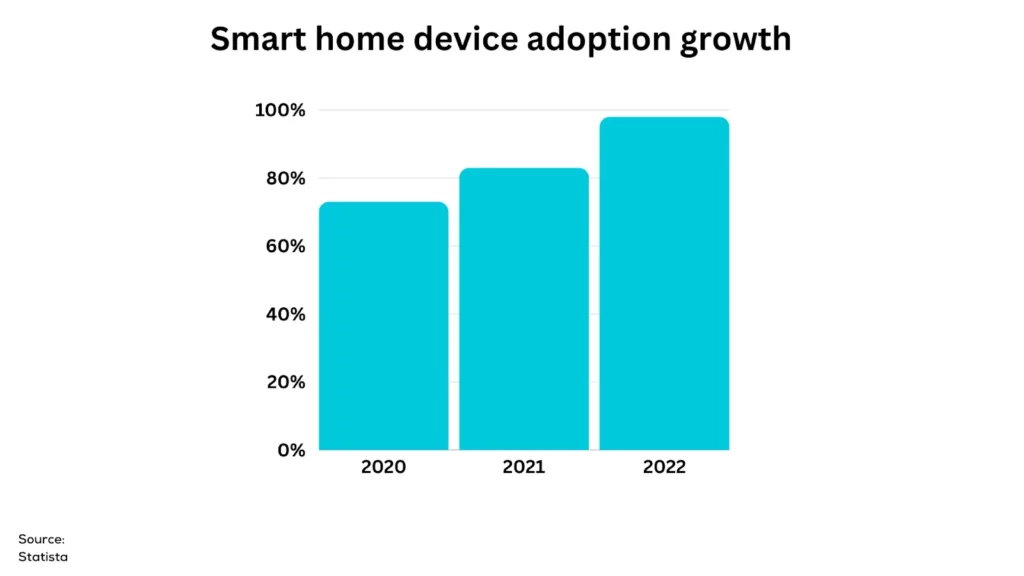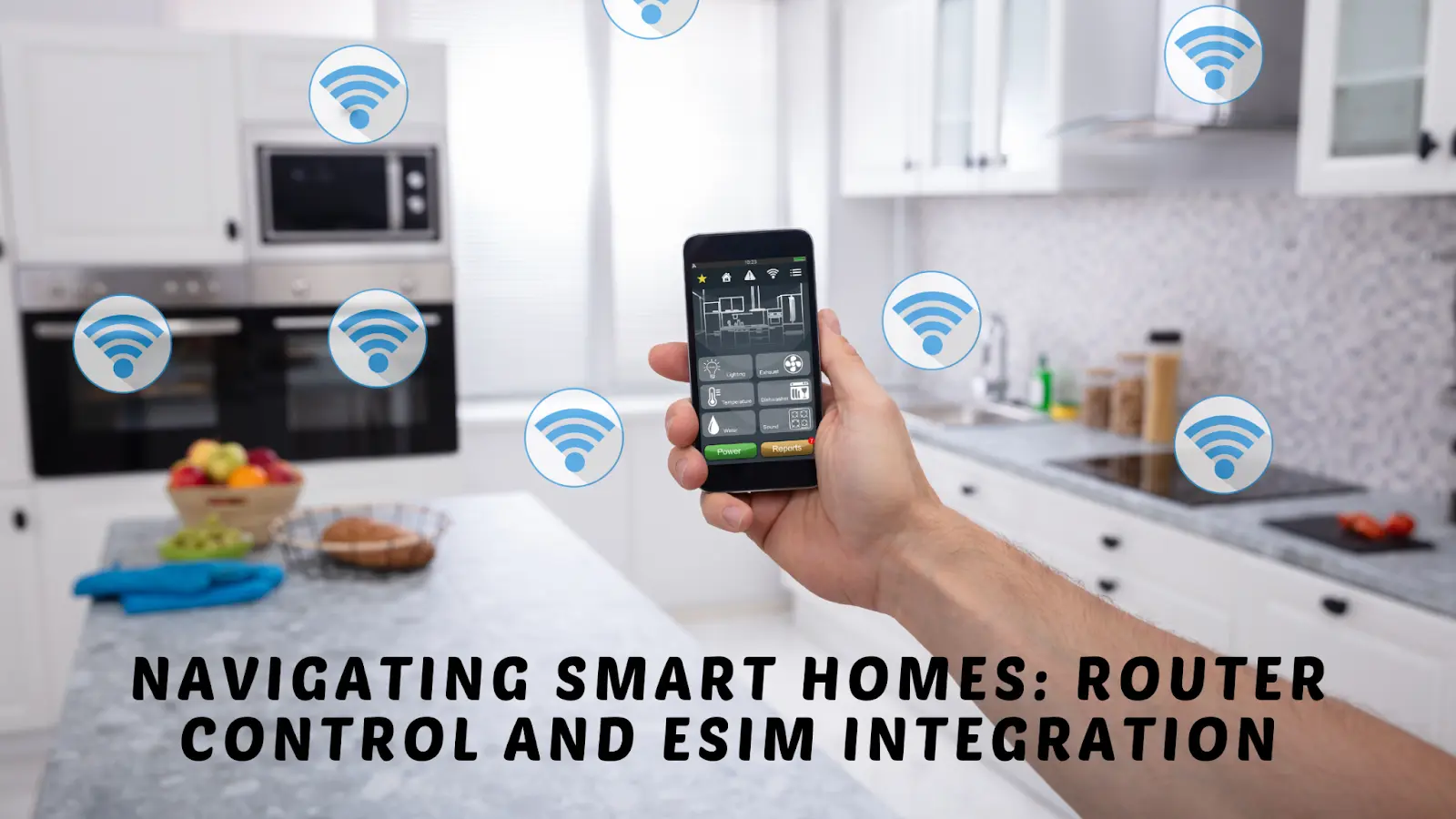Smart home tech is advancing quickly. Homes now possess more connected devices than ever before. Managing this web of connections can be hard. Managing this without proper router control and integration solutions can be challenging. This blog explores the evolution of smart home needs and advanced router techniques. It also looks at the eSIM technology revolutionizing connectivity. It covers strategies for enhanced control by combining router management with eSIMs.
CONTENTS
The Evolution of Smart Home Connectivity
The average US household now has over many connected devices, as smart home adoption sees unprecedented growth. The variety and number of connected devices are growing. Managing their web of Wi-Fi, Bluetooth, and cellular links is now a big challenge. Old routers cannot handle it all. They strain to do many things at once: host multiple video streams, run automation, keep security, and manage internet traffic. Low-powered home sensors use finicky protocols like ZigBee rather than Wi-Fi. Their uptime suffers without careful connectivity oversight.
Smart homes now resemble intricate, woven webs of connections.” Sentence: “Their uptime suffers without careful connectivity oversight. The need for strong router control is higher than ever. Strategic optimization is no longer an option but a baseline requirement for smooth operation in contemporary smart households.
Robust router management gives smarter connections. But, eSIM technology leads the future with the simplicity and flexibility it needs. eSIMs, or embedded SIMs, integrate the SIM card function directly into devices, streamlining smart home rollouts via:
● Remote over-the-air provisioning without physical SIMs
● Flexible cellular data plans tailored to each device’s usage
● Seamless global connectivity with one eSIM supporting multiple profiles
● Simplified inventory tracking with a single device SKU
The eSIM integration process allows changing operators instantly without device replacements. For smart homeowners, this means easier setup and cost savings. It also means they get unlocked global features in a SIM-swap-free system.
With eSIM for India and other regions steadily adding compatibility, the technology promises to make domestic and international smart home connectivity more accessible.

Advanced Router Control Techniques for Smart Homes
Smart homes are now microcosms of intricate, woven connectivity. Advanced router setups make this possible. Some best practices include:
- Mesh network implementation for eliminating dead zones and boosting range.
- QoS protocols prioritizing high-bandwidth applications like video streaming
- Enhanced security via firewalls, VPNs, and real-time monitoring
- Automatic firmware updates for performance improvements and vulnerability patching
For large smart homes, enterprise-grade router functionalities take optimization further with:
- Centralized management platforms
- Granular visibility into connected device insights
- Role and policy-based access stratification for IoT devices
- Automated traffic shaping and bandwidth allocation
eSIM Integration Challenges and Solutions
Transitioning to eSIM connectivity also poses challenges. These include device compatibility limits, patchy operator support, and a cap on eSIM profiles per device. Multi-profile capabilities currently max out at around eight profiles.
Compatibility issues arise from the variety of proprietary eSIM architectures adopted by SOC vendors. However, integrators can focus on leading LPWAN platforms. Examples include NB-IoT, which consistently supports eSIMs.
Working with supportive operators like Orange and active eSIM vendors removes obstacles. It helps roll out eSIM-based smart home systems. Open communication prevents profile allocation issues as your device count scales over time.
Combining Router Control with eSIM for Enhanced Connectivity
Advanced router management delivers smart coordination. eSIM simplifies setup. Combining both unlocks the next-gen smart home. It’s defined by innovations like:
● Real-time traffic steering – Dynamically switching device connectivity across different network mediums like managed Wi-Fi, LTE, and 5G for optimal quality.
● Multi-carrier aggregation – Bonding bandwidth channels from an eSIM’s cellular profiles together with the home’s router for maximizing throughput.
● Granular quality optimization – Configuring precise QoS parameters per application, cellular account data allotment, and connected device capabilities.
● Secure remote network access – VPN infrastructure for administrators to securely configure and control smart home routers and eSIM profiles remotely.
● Over-the-air updates – Router firmware and all eSIM devices update automatically for continuous performance improvements.
We see glimpses of this future already. New mesh network platforms, like Netgear Orbi 9, use built-in eSIMs in the router. This makes connectivity simpler. Startups like Lidum use meshed Wi-Fi with LTE failover. It ensures constant bandwidth for all connected IoT devices.
Cellular-equipped products are now fixtures in smart homes, from security cameras to irrigation controllers. Routers will need to get smarter. They must act as hubs, routing traffic based on device needs, usage patterns, and network conditions.
The top networking hardware vendors expect this trend. They are evolving router technology to better include cellular connectivity. Cisco, D-Link, Netgear, and Asus made recent announcements. They confirmed their router product families will work with eSIMs. Some will use supporting modules or add-on dongles. Others will have eSIM radios built into the router hardware.
Homes are only getting more connected with each product cycle. Router control and eSIM integration are the tip of the spear. They simplify smart home management today and set up more autonomous features for the future. Mobile and Wi-Fi tech are entering their next chapters. Smart platforms will continue to innovate. It starts with the router as the master conductor.
Future Trends in Smart Home Connectivity
eSIM and advanced routing are dissolving old barriers. 5G and Wi-Fi 6 are the next milestones for harmonizing smart home management.
5G has high-speed, low-latency connectivity. It will minimize interference. It can support more simultaneous smart home devices. This will provide better capacity and responsiveness. This sets the stage for innovations. For example, smart home hubs control a home’s whole connected system.
Meanwhile, Wi-Fi 6 router certification aims to improve smart device connections. It also aims to increase range, cut congestion, and improve IoT functionality.
As these wireless standards evolve, so will the art of smart home connectivity. Internet speeds are set to hit 1,000 Mbps in forward-looking homes. The router will become an even more critical path for streaming, analytics, and automation.
FAQs: Common Queries
How does router control enhance smart home security?
Router control improves smart home security. It does this through features like firewalls and encrypted VPNs to prevent MITM attacks. It can also isolate IoT devices into separate VLANs. This protects other connected equipment if an IoT camera, for instance, gets breached.
Can eSIM technology fully replace traditional SIM cards in smart homes?
Most industry experts see eSIMs replacing physical SIM cards. They offer flexibility and remote provisioning. But, traditional SIMs will co-exist with eSIMs for 5+ years. Smart home developers will transition gradually amidst tech improvements.
What are key considerations when setting up networks supporting router control and eSIM?
Key steps include checking if the router and IoT device use eSIMs. Also, the assigned eSIM profiles, cellular operator support, security features, and router updates for long-term performance.
Conclusion
Homes are only growing more connected with each product cycle. Router control and eSIM integration represent the tip of the spear. They simplify smart home management today and prepare for more autonomous functionality in the future. Mobile and Wi-Fi tech are moving to their next chapters. Smart platforms will keep innovating. They will start with the router.

Hey, I’m Jeremy Clifford. I hold a bachelor’s degree in information systems, and I’m a certified network specialist. I worked for several internet providers in LA, San Francisco, Sacramento, and Seattle over the past 21 years.
I worked as a customer service operator, field technician, network engineer, and network specialist. During my career in networking, I’ve come across numerous modems, gateways, routers, and other networking hardware. I’ve installed network equipment, fixed it, designed and administrated networks, etc.
Networking is my passion, and I’m eager to share everything I know with you. On this website, you can read my modem and router reviews, as well as various how-to guides designed to help you solve your network problems. I want to liberate you from the fear that most users feel when they have to deal with modem and router settings.
My favorite free-time activities are gaming, movie-watching, and cooking. I also enjoy fishing, although I’m not good at it. What I’m good at is annoying David when we are fishing together. Apparently, you’re not supposed to talk or laugh while fishing – it scares the fishes.

